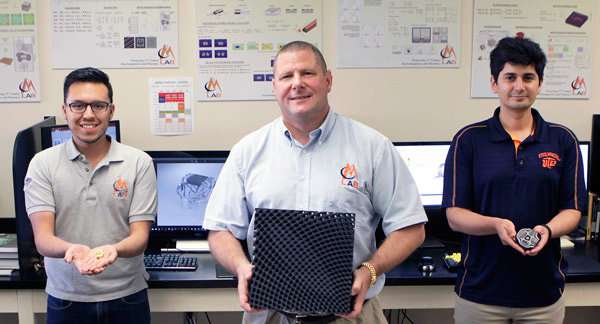A great many discoveries have been made in the lab of Raymond C. Rumpf, PhD, the Schellenger Professor in Electrical Research in The University of Texas at El Paso’s College of Engineering. Dr. Rumpf leads the EM Lab, which is dedicated to the research and development of advanced concepts in electromagnetics and photonics technologies enabled by 3D printing. The latest advancement made by the lab is an exciting one – earlier this year, the researchers completed the first true three-dimensional volumetric circuit using a fully automated process. According to Dr. Rumpf, the breakthrough may change the way that electrical products are designed and manufactured.
“This is a very significant step and potentially disruptive achievement,” Dr. Rumpf said. “There are many other large research groups that have been chasing this. It’s what everybody in this field is working toward and talking about, yet nobody has yet achieved it. It’s sort of the holy grail for 3-D printed circuits, and it was accomplished here at UTEP.”
A three-dimensional circuit can be made smaller, lighter and more efficient than other circuits, and 3D printing allows them to be manufactured into arbitrary form factors that can be integrated into any object or surface. Years of research went into the idea, according to Dr. Rumpf.
“The last three years were spent developing futuristic CAD (computer-aided design) tools, to produce 3-D/volumetric circuits,” he said. “These tools do not exist anywhere else.”
Rumpf worked with fellow EM Lab researchers Gilbert Carranza, Ubaldo Robles, and Cesar Valle. Carranza, a doctoral student, used an open source CAD software to integrate his custom functions that allowed the lab to design true 3D circuits.
“I built a custom tool that allows us to place electric components in any position and in any orientation,” Carranza said. “We can route the electrical interconnects throughout all three dimensions following smooth paths.”
He worked on the first version of the software for a year.
“We couldn’t go anywhere beyond that,” he said. “We didn’t have the necessary tool to actually translate my design into something that could be read by our 3-D printer.”
Robles and Valle, also doctoral students, were able to help. Earlier in the summer, Robles completed an interface that could convert the circuit design into code that the 3D printer could use to print the circuit in one step. Valle and Carranza then fine-tuned the process and used it to build the first 3D volumetric circuit.
“Getting the CAD, code generator, and 3-D printer to play along well together proved the most difficult step,” Valle said. “Typically, when you make a circuit, it’s two steps. You start with a thin sheet of plastic. On top of that, you form metal traces, then put electrical components onto that. What our tool does that is unique is it combines these processes, and it does it in three dimensions with complete design freedom. We are now able to load 3-D files, hit ‘run’ and out comes the part. Literally ‘File,’ ‘Print.'”
 The applications for the technology are many. Because circuits can now be built into any surface or shape, electronics can be built into anything without any added weight or bulk.
The applications for the technology are many. Because circuits can now be built into any surface or shape, electronics can be built into anything without any added weight or bulk.
“We can make circuits in any form or fashion,” Rumpf said. “You could put circuits in munitions, in eyeglasses, in shoes, and even in coffee mugs. You can be at a restaurant drinking coffee and, when the liquid gets down to a certain level the server gets notified before you have to say anything. It’s about making electronics ubiquitous in many different things.”
He believes that this will open the door for small businesses to become electronics manufacturers, just by purchasing a 3D printer.
“In the future, I don’t think you will see places, such as major electronics manufacturing companies, churning out billions of things and dominating the market nearly as often,” Rumpf said. “Instead, you may have thousands of small businesses in the U.S. churning out thousands of products, both mass-produced and customized. Our 3-D circuit technology may be the first step to change the paradigm of circuit manufacturing. And it may enable us to exploit and incorporate new physics in traditional planar (2-D) circuitry.”
Discuss this and other 3D printing topics at 3DPrintBoard.com or share your thoughts below.
[Source: Phys.org/Images: UTEP]
Subscribe to Our Email Newsletter
Stay up-to-date on all the latest news from the 3D printing industry and receive information and offers from third party vendors.
You May Also Like
3D Printed Heat Spreader Could Improve Efficiency of Electronics
The low-hanging fruit for decarbonization has long been improving the efficiency of existing systems, hence the justification for LED lights and ENERGY STAR certified appliances. While such minor moves are...
3D Printing News Unpeeled: Marine Gearboxes, 3D Printed Motors and $1.7 Million in Seed Funding
UK based Equipmake just released their Ampere-220 e-axle system. The system, which is meant for high performance electric cars, was similar to one released on the Ariel HIPERCAR. It has...
CEAD Unveils 36-Meter-Long 3D Printer for Abu Dhabi’s Al Seer Marine
CEAD, a Dutch original equipment manufacturer dedicated to large-format 3D printers, has unveiled what it claims to be the world’s largest robotic arm-based 3D printer. At 36 meters long and...
3D Printed Biocomposites Could Help Reduce Marine Plastic Pollution
Concerns about the impact of plastic litter and microplastics in the oceans are at the forefront of environmental study. For decades, the marine environment has suffered from the degradation of...






































